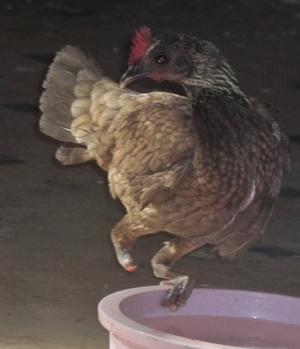Quote:
I'm da*n sure not an expert, I just have dying birds

But the L & S in "L-S 50" stands for lincomycin-spectinomycin-so you're right-that's what they use and that's what mine are on now. It's powder I'm mixing in the water. The other Cochin babies (14 wks now) still look and act so good and the Silkies (16 wks) are all acting good. My little Cochin pullet I've had to the vet 3 times probably won't make it another 12 hrs, same with my daughter's pet cockeral. I've wracked my brain trying to figure out the best way to deal with this. I've got big round pans with bleach and water that I step in before I go into each chicken's area. The Cochin babies are completely isolated in their pen but they always have been. I'm raking up every speck of poop in their pen all the time and am going to continually spray down with Oxine in there, their coop, change shavings in their coop every day if I have to. He said to be prepared because I was going to lose more. But I'm hoping he's wrong.
What makes me just sick is the Cochin pen really is isolated and the most protected one. *I* brought this crap into their pen on my shoes. That's hard to swallow.
I can get a couple ccs of the injectable if you'd like to try that, it's %100. Let me know if you'd like some
You're awesome to offer and I appreciate it very much. But I went ahead and had to buy a whole bottle of the L-S 50 so I've got enough now. I'm going to have him put down my little Cochin pullet when we go in today at 3:00. She's in bad shape and won't eat or drink or move now. I can't just leave her like that until she dies and I certainly can't kill her myself. At least I can be there when he euthanizes her.
If anyone is concerned about e. coli there's a great article at
http://www.vetafarm.com/pages/E.coli-%2d-myths-and-misunderstanding-.html
Adults aren't really affected, it's the younger ones for the most part-because the bacteria is literally everywhere and there's so many different strains. I wasn't going to hatch any more chicks or buy any more babies anyway, I sure want to keep the ones I've already raised through this long hot summer though. So at least my adults should be fine. So bleach your shoes and hands and change clothes before you mess with your chickens after you've been to a chicken show, swap or auction.
I'm da*n sure not an expert, I just have dying birds

But the L & S in "L-S 50" stands for lincomycin-spectinomycin-so you're right-that's what they use and that's what mine are on now. It's powder I'm mixing in the water. The other Cochin babies (14 wks now) still look and act so good and the Silkies (16 wks) are all acting good. My little Cochin pullet I've had to the vet 3 times probably won't make it another 12 hrs, same with my daughter's pet cockeral. I've wracked my brain trying to figure out the best way to deal with this. I've got big round pans with bleach and water that I step in before I go into each chicken's area. The Cochin babies are completely isolated in their pen but they always have been. I'm raking up every speck of poop in their pen all the time and am going to continually spray down with Oxine in there, their coop, change shavings in their coop every day if I have to. He said to be prepared because I was going to lose more. But I'm hoping he's wrong.
What makes me just sick is the Cochin pen really is isolated and the most protected one. *I* brought this crap into their pen on my shoes. That's hard to swallow.
I can get a couple ccs of the injectable if you'd like to try that, it's %100. Let me know if you'd like some
You're awesome to offer and I appreciate it very much. But I went ahead and had to buy a whole bottle of the L-S 50 so I've got enough now. I'm going to have him put down my little Cochin pullet when we go in today at 3:00. She's in bad shape and won't eat or drink or move now. I can't just leave her like that until she dies and I certainly can't kill her myself. At least I can be there when he euthanizes her.
If anyone is concerned about e. coli there's a great article at
http://www.vetafarm.com/pages/E.coli-%2d-myths-and-misunderstanding-.html
Adults aren't really affected, it's the younger ones for the most part-because the bacteria is literally everywhere and there's so many different strains. I wasn't going to hatch any more chicks or buy any more babies anyway, I sure want to keep the ones I've already raised through this long hot summer though. So at least my adults should be fine. So bleach your shoes and hands and change clothes before you mess with your chickens after you've been to a chicken show, swap or auction.





